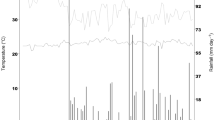Summary
The intereropping of common bean (Phaseolus vulgaris L.) and maize (Zea mays L.) is a common practice in the Northwest of the Iberian Peninsula. In this experiment, 25 populations of bush bean were evaluated for nutritional and culinary traits of dry seed and immature pod in sole crop and in intercrop in two years and in two locations, in order to determine whether selection of bush bean in sole crop can result in genetic progress for intercrop.
There were no differences in the population means between cropping systems. Significant differences were detected among populations for all traits tudied except starch content, crude ash, water absorption and coat proportion. Population x environment interaction was significant for pod thickness. Bean populations did not interact with cropping systems for any trait, although there were differences between cropping systems for crude protein. These results suggest that a sole crop system provides sufficient information to select bean populations efficiently for the bush bean-maize intercropping system, although the advanced generations of the breeding program should be tested for quantitative traits such as protein content in the appropriate cropping system (intercropping) to know the competitive ability with the associated species. This would permit to choose bush bean populations which complement more efficiently and would be less competitive with the maize population.
Similar content being viewed by others
References
Boletin Oficial del Estado (BOE). 1989. Métodos Oficiales de Análisis de Alimentos para Animales (Piensos) y sus Primeras, Materias 128: 16023–16084.
Bouchr, D. & J. Espinosa, 1982. Cropping systems and growth and nodulation responses of beans to nitrogen in Tabasco, Mexico. Trop Agric. (Trinidad) 59: 279–282.
CIAT, 1983. Etapas de desarrollo de la planta de frijol común. Guía de Estudio. CIAT (Centro Internacional de Agricultura Tropical). Cali. Colombia.
Clark, A.E. & C.A. Francis, 1985. Transgressive yielding in bean: maize intercrops: interference in time and space. Field Crops Res. 11: 37–53.
Davis, J.H.C. & J.N. Woolley, 1993. Genotypic requirement for intercropping. Field Crops Res. 34: 407–430.
Esctibano, M.R., M. Santalla & A.M. de Ron. 1990. Preliminary study of quality characters in populations of common bean from the northwestem lberian Peninsula. An. Aula Dei 20 (1–2): 189–198.
Escribano, M.R., A.M. de Ron & J.M. Amurrio. 1994. Diversity in agronomical traits in common bean populations from northwestein Spain. Euphytica 76: 1–6.
Ghaderi, A., G.L. Hosfield, M.W. Adams & M.A. Uebersax, 1984. Variability in culínary quality component interrelationship, and breeding implications in navy and pinto beans. J. Amer. Hort. Sci. 109: 85–90.
Gil, J. & A.M. de Ron, 1992. Variation inPhaseolus vulgaris in the Northwest of the Iberian Peninsula. Plant Breed. 109: 313–319.
Hosfield, G.L., 1991. Genetic control of production and food quality factors in dry bean. Food Technol. 45 (9): 98 & 100–103.
Kelly, J.D. & F.A. Bliss, 1975. Heritability estimates of percentage seed protein and available methionine and correlations with yield in dry beans. Crop Sci. 15: 753–757.
Moreno, M.T., A. Martínez & J.I. Cubero, 1985. Bean production in Spain. In: The Ford Foundation, Centro Internacional de Agricultura Tropical (CIAT), International Center for Agricultural Research in Dry Areas (ICARDA) (Eds). Potential for Field Beans (Phaseolus vulgaris L.) in West Asia and North Africa. pp. 70–85.
Ogenga-Latigo, M.W., J.K.O. Ampofo & C.W. Baliddawa. 1992. Influence of maize row spacing on infestation and damage of intercropped beans by the bean aphid (Aphis fabae Scop.). I. Incidence of aphis. Field Crops Res. 30: 111–121.
Ron, A.M. de, R. Lindner, R.A. Malvar, A. Ordás, J.J. Baladrón & J. Gil, 1991. Germplasm collecting and characterization in the North of the Iberian Peninsula. Plant Genet. Resour. Newsl. 87: 17–19.
Santalla, M., A.M. de Ron & M.R. Escribano, 1994. Effect of intercropping bush bean populations with maize on agronomic traits and their implications for selection. Field Crops Res. 36: 185–189.
Stem, W.R., 1993. Nitrogen fixation and transfer in intercropping. Field Crops Res. 34: 335–356.
Willey, R.W.: 1979. Intercropping — its importance and research needs. Part 1. Competition and yield advantages. Field Crop Abstr. 32 (1): 1–10.
Author information
Authors and Affiliations
Rights and permissions
About this article
Cite this article
Santalla, M., de Ron, A.M. & Casquero, P.A. Nutritional and culinary quality of bush bean populations intercropped with maize. Euphytica 84, 57–65 (1995). https://doi.org/10.1007/BF01677557
Received:
Accepted:
Issue Date:
DOI: https://doi.org/10.1007/BF01677557




